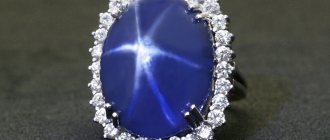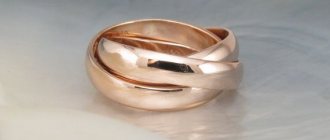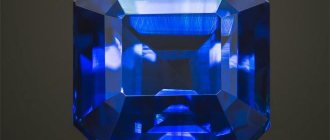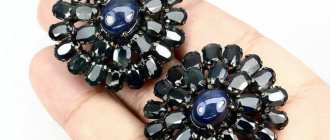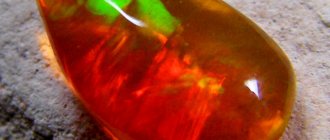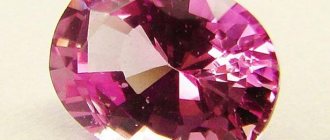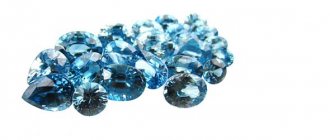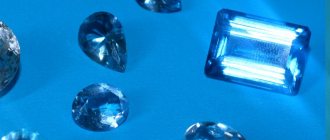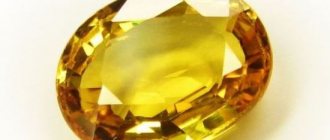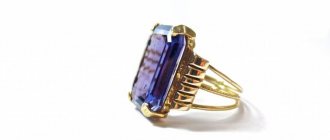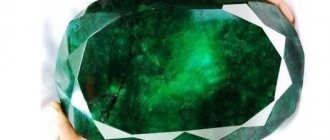On the jewelry market you can easily find synthetic sapphires (the label will indicate “gt” or “s”, i.e. synthetic). The question often arises: what is the difference between synthetic and artificial sapphires and natural ones? How to distinguish a real mineral from an artificially grown one? What are their similarities and differences, how much do the prices for natural and synthetic stones differ?
Description of artificial sapphire
Synthetic sapphire is obtained artificially.
This sapphire has an even color and bright shine. There are no chips, cracks, natural inclusions or other defects that natural gems have. In mineralogy, sapphires are stones that are exclusively blue in color. Sapphire corundums can be either transparent or colored in different colors, mainly blue and dark blue.
Nanosapphire is not afraid of temperature effects, ultraviolet rays, and lends itself well to cutting. When selling jewelry with such a stone, it must be marked “g/t” or “synthetic,” indicating the artificial origin of the stone. If the mark is missing, the seller is breaking the law by selling artificial stones under the guise of natural minerals.
Varieties and colors
Synthetically produced stone is colorless. It is called leucosapphire. The high strength, heat resistance, and transparency of the mineral allow it to be used in industry in the production of microcircuits, LEDs, and screens in mobile devices.
In jewelry, colored varieties of corundum are more often used. The most common sapphires are blue and light blue, because... they more faithfully imitate the original.
Other shades are also available:
- pink;
- orange;
- yellow;
- green;
- violet;
- black.
In jewelry, there are various shades of sapphires.
Scientists have learned to grow synthetic star sapphire. This stone creates an unusual optical effect.
When illuminated, a light spot with rays diverging in different directions can be seen on the surface of the gem.
Why are hydrothermal sapphires created?
Natural blue corundum is quite rare in nature, and therefore its cost is extremely high. It was the factors of color and price that led to the development of hydrothermal gems. To obtain blue sapphire, special equipment is used that colors and heats the material to high temperatures. Thanks to modern technologies, there are many products made from synthetic grown stones on the jewelry market all over the world. Their purpose is to satisfy the population’s needs for the purchase of cheap analogues of blue corundum.
History of creation
The first attempts to create artificial sapphire were made by the French chemist Auguste Verneuil in 1886. After 16 years, he managed to obtain a single crystal by melting metal oxides in a burner fire at a certain temperature and then cooling them.
Later, Verneuil's home laboratory turned into industrial production, which began to produce up to 3 tons of corundum per year. This method of producing artificial stones, called the Verneuil method (process), is still used to this day.
Methods for producing artificial crystals
Nanosapphires are synthesized on an industrial scale around the world. In addition to the Verneuil method, other technologies are also used.
The Kyropoulos method is based on growing corundum from molten aluminum oxide. The seed crystal is immersed in a liquid medium, where its growth begins with the help of heating. It is gradually pulled out of the melt, continuously rotating around its axis.
Synthetic sapphires are synthesized all over the world.
Other methods for producing sapphires from melt (Czochralski, Stepanov) are based on moving a crystal or container in a temperature gradient field. With this method, the temperature values of the melt are equal to or slightly higher than the melting point. The lower part of the seed crystal is constantly in contact with the melt. The crystal grows down around the seed and is pulled out into a monolithic cylinder.
Method of making sapphire
There are 2 ways to obtain synthetic sapphire in the laboratory:
- A mixture of starting materials (aluminum oxide and color additives) in powder form is poured into a vibrating hopper with special holes. The powder spills into the furnace through tubes from the holes, while oxygen and hydrogen are supplied at the same time. When hydrogen burns, it melts the mixture and a crystal begins to grow.
- Nano-sapphires are grown using aluminum oxide as a base. To do this, the seed plates are placed in special devices where the required pressure and temperature up to 5000 °C are maintained.
Watch a program about growing stones in a special factory:
Post-cultivation treatment
To prevent cracking, the resulting sapphires are subjected to post-growth annealing in special installations. Subsequently, they are given the desired shape using laser grinding and polishing with suspensions and pastes. Due to the fragility of the material, processing using lathes, drilling and grinding machines is not used.
Synthetic sapphires are colored and refined using various technologies: diffuse treatment with metal salts, heating, and ultraviolet irradiation.
Properties of artificial sapphire
Artificially grown corundum is similar in appearance to real stone and has an identical crystal structure. It has high strength and high shine. The degree of transparency of stones can vary: from transparent colorless (leucosapphire) to opaque black.
Physico-chemical
The main structural element of synthetic corundum is aluminum oxide. The relative surface hardness value is 9 points on the ten-point Mohs scale. Density - 3.93 g/cm³. Melting point is above 2000 ºC. The mineral reacts chemically with acids and dissolves in them.
Aluminum oxide is the main structural element of sapphire.
Medicinal
Like many gems, sapphire has medicinal properties and is used in alternative medicine. It affects both the physical and spiritual state of a person.
It is believed that the mineral helps with diseases of the musculoskeletal system and diseases of the circulatory system. Wearing amulets with this stone improves vision and hearing, and helps get rid of skin pathologies. Constant contact with sapphire improves mood, reduces symptoms of apathy and depression, and relieves insomnia.
Magical
Blue corundum is a symbol of fidelity, chastity and modesty. It helps its owner find love and improve relationships with a marriage partner. Sapphire is a protector from negative otherworldly phenomena: the evil eye, damage, love spells. It also protects from the influence of envious people, gossips and slanderers. The gem gives determination and courage to an insecure person.
The mineral is believed to have powerful positive energy. It helps to develop the best human qualities: kindness, responsiveness, compassion. It gives inspiration to creative people and stimulates them to search for non-standard approaches to implementing projects.
Blue corundum will protect against the evil eye and damage.
Blue sapphire is the main symbol of the 45th wedding anniversary.
On this day, spouses exchange wedding rings with inserts made of this mineral.
Chemical composition and physical properties
There are several versions explaining the origin of the name of the stone. According to one of them, the name now known is similar to the Babylonian word “sipru”, which translated means scratching. Most jewelers agree with this interpretation, since the mineral is very hard. The gem has the following characteristics:
- The base element is aluminum oxide, which has no color.
- Impurities of iron, manganese, and titanium are responsible for the coloring.
- Sapphires naturally require an alumina-rich environment to form.
- Hardness is 9.
- Density - 4 g. /cub. cm.
- X-ray irradiation can enhance the shade.
- As a result of heating, a less vibrant color is obtained.
Characterized by correct structure. The most valuable specimens are mined in Sri Lanka, Madagascar, Kashmir and Myanmar. The stone is found in Australia, Kenya, USA, Tanzania, Thailand, Cambodia. A small number of deposits helps to give an accurate answer to the question of whether a sapphire stone is precious or semi-precious. Aluminum oxide crystal belongs to the first group of noble minerals.
Areas of application
In addition to the jewelry industry, nanosapphires are also used in other areas:
- Medicine . Leucosapphires are used as a material for the manufacture of surgical blades, artificial eye lenses, optical elements of diagnostic devices, and braces in dentistry.
- Optical industry . Nanosapphire is a raw material for the production of large-sized optics, protective glasses, lenses, and prisms.
- Instrument making . The synthetic mineral is used as substrates for semiconductor microcircuits and optoelectronic devices.
- Laser technology . The mineral is used to produce titanium-sapphire lasers and amplifiers.
- Aviation and Rocket Science . The hard stone is used to make thin, impact-resistant glass for aircraft and space station windows.
In construction, sapphire is used to produce new generation thermal insulation materials.
Jewelry with synthetic stone
Artificially grown stones can reduce the cost of jewelry with inserts. In terms of their structure and physicochemical properties, they are complete analogues of natural minerals. Externally they are even superior to the original.
Jewelry with synthetic stones can reduce the cost of the product.
Natural rocks do not always have a smooth surface without cracks and foreign inclusions. Sapphire corundum is free from all these disadvantages: jewelry with such stones looks more attractive from an aesthetic point of view.
What to look for when choosing
When purchasing a product with sapphire corundum, you need to pay attention to the tag, which should indicate information about the artificial origin of the mineral. The stone is best viewed in good light under a magnifying glass. The crystal grown in the laboratory has an even color and is transparent. The only foreign inclusions that can be seen are air bubbles.
How to wear and care
Nanosapphires are durable and resistant to mechanical stress, so they do not require special care. When dirty, clean them with running water or soapy water, and then wipe with a soft cloth. It is better to store items with sapphires in a separate fabric bag, since due to the high strength of the stone they can damage other jewelry.
Corundums should not be thrown or dropped. Despite their hardness, microcracks may appear in them, which subsequently leads to destruction. Chips on the surface spoil the appearance of the products.
What does the name nano sapphire mean?
This is a designation for crystals that exactly replicate a natural gem. Today they are widely used instead of real stones, since nano sapphires have a lower cost. This classification applies to minerals that were grown artificially in the laboratory.
Such stones are extremely difficult to distinguish from natural ones due to their extreme similarity. They have the same hardness, weight, and appearance. The main difference between a nanostone and a fake is that advanced technologies and expensive materials are used for its production.
Technologies for creating artificial gems are constantly evolving. Today, experts create them so similar to natural ones that only an experienced jeweler can find the differences.
Doublets with natural sapphires
Doublets are composite stones made up of 2 layers. A thin plate of real sapphire forms the top layer, and an artificial mineral or a cheap imitation of it is glued underneath it. Doublets are often made from damaged stones when it is necessary to hide defects.
Doublets are made from damaged stones.
The glue is selected so that it matches the color of both the top and bottom layers. You can identify a doublet using a magnifying glass. It is enough to look at the stone from the side to detect the border between the two halves.
How to wear and care for sapphire
Astrologers advise buying jewelry on the 8th lunar day, and putting it on for the first time on the 22nd. On which finger to wear a sapphire ring? On the index hand of the right hand, then the stone will maximize its best properties: bring good luck, prosperity, make a person wiser and more resilient.
An engagement ring with blue corundum will bring good luck in your family life. In case of an accidental disagreement with your spouse, you need to put a ring on the ring finger of your right hand so that the problem goes away.
For men, large rings, matching cufflinks, and tie pins with a dark-colored stone are suitable.
Brunettes look good with deep blue stones, while blondes look good with light ones.
A modest ring with a medium-sized sapphire placed on your finger looks appropriate in the office. It can be set in silver or white gold. For special occasions, large jewelry is chosen.
For a piece of jewelry to delight its owner with its pristine beauty for many years, little is required:
- avoid falling stones, any strong mechanical impact, interaction with chemicals, cosmetics;
- remove jewelry when performing household chores (laundry, washing dishes, cooking);
- do not swim in it, do not stay in direct sunlight for a long time;
- store separately from other jewelry in a box upholstered in soft fabric;
- clean with a soft cloth in a soap or saline solution, then rinse with clean water.
With proper care and careful storage, the precious jewelry will become a family heirloom and will be gratefully received by the heirs.
Other imitations of natural corundum
Synthetic corundum is a structural analogue of a natural crystal, but differs from it in the chemical composition and content of microimpurities. From an aesthetic and practical point of view, it is the most acceptable copy of natural sapphire.
Natural imitations of opaque sapphire include specimens obtained from waste natural stones by gluing or pressing. This group also includes colored natural minerals of other rocks.
Cheap fakes are made from glass alloys, which contain metal oxides to obtain the desired color.
Opaque stones are imitated using colored plastics.
Mineral deposits
There are not so few sapphire deposits on the planet, but there are only two crystals with perfect or close to perfection:
- Kashmir (region of the Hindustan Peninsula). The rarest and most valuable stones of the perfect cornflower blue color are found there. There are very few of them (less than 5% of total production), so they are expensive.
- Sri Lanka (island in southern Asia). A little east of Hindustan, on a neighboring island, rare blue and pink sapphires, called “Ceylon”, are mined.
A large number of corundums (about a quarter) are extracted from the bowels of the Australian soil, but they are much inferior in quality to the first two options. Sapphire is found in smaller quantities in the USA and China, Thailand, Burma and Vietnam. As for Russia, there are no large deposits on its territory, although there are small quantities of sapphires in the Urals. They have a grayish tint.
This is interesting!
An unusual story happened in the sixties of the twentieth century with a young man from the USA, whose name was Steve Mayer. He and his friend often explored abandoned quarries and gorges. In one of these quarries near the small town of Canton, a man picked up a large blue sapphire crystal weighing 3,500 carats, but mistook it for rock crystal. He worked as a radiologist and found it very convenient to use the stone as a paperweight, until one of his patients advised Steve to take the stone to a jeweler, or better yet, a gemologist.
How to distinguish natural sapphire from imitation
Only an expert can distinguish a natural sapphire from sapphire corundum or a skillfully made fake. In order not to make a mistake with your choice, you should purchase jewelry in reliable stores, check the labeling, and ask the seller clarifying questions.
It is difficult to distinguish natural sapphire from imitation.
The artificial origin of the stone can be revealed by microscopic air bubbles or dust particles that got inside the crystal during its growth. High-quality doublets are difficult to recognize, since the gluing area is often hidden by the frame.
Mechanical impact
The surface of natural sapphires, like their lab-grown counterparts, is free from scratches from sharp objects. It’s easy to scratch a cheap glass or plastic fake.
The place where the doublet is glued will appear more clearly if you immerse the stone in an oily liquid. In this case, the boundaries of 2 interconnected rocks will take on a different shade.
Official methods
Microscopic examination reveals differences between natural and artificial corundum. A growth structure uncharacteristic of natural formation is revealed by a synthetic stone. Titanium impurities are often added to nanosapphires, which give them a blue or blue color. Under the light of an ultraviolet lamp, the artificial analogue acquires a greenish tint, which indicates the presence of foreign impurities.
Designations on jewelry tags
First of all, we note that the designations on jewelry tags refer to precious stones of natural origin. The first number indicates the number of stones in the product, 1, 2, etc. Then the name of the stone is abbreviated. For example, Sp. means sapphire and that the stone is natural, natural. Sp.ob. – means diffusion or ennobled.
Also indicating Sp. cor. – that is, corundum, which means that the product contains a hydrothermal mineral. Next, the tag indicates the shape of the cut - for example, Gr - pear, Kv - square, Tk - triangle. Then there are the digital characteristics of the gemstone - weight, color, clarity.
Hydrothermal, like all synthetic minerals, do not (and cannot have) the digital characteristics of color and purity on jewelry tags that are inherent in natural ones!
Which sapphire is better to choose: natural or synthetic
Natural stones are several times more expensive than their synthetic counterparts. This is explained by the cost of products, which includes production and sales costs. Deposits of natural minerals are drying up every year. In addition, large resources are spent on mining gems, which also increases the final cost of jewelry.
Natural stones are very expensive.
The production of synthetic corundum is cheaper. But this does not mean that the stone obtained artificially is worse. It often looks more aesthetically pleasing than the original and has brighter colors. In structure and composition it is identical to natural minerals.
Declassed and diffusion sapphire - what is it?
Diffusion is used as one of the methods for refining gems. This means that, for example, to refine sapphire with the effect of asterism, diffusion with beryllium salts is used. As a result of strong heating and high pressure, salts penetrate deeply into the gem, passing through it and the asterism effect is significantly enhanced.
The diffusion method is divided into two types:
- Impregnation of the outer layer of the gem, which hides the real color of the sapphire.
- Internal - under the high temperature of inclusion in corundum, for example, titanium and chromium dissolve, and artificial coloring of the stone occurs.
Regardless of what type of refining was used, they are considered legal, but only in cases where jewelers do not sell the resulting gem as natural. The documents for the sapphire must indicate what manipulations were carried out on it.
Declassed stone does not belong to diffusion, synthetic - it is a natural mineral of low quality. It may be cloudy or opaque. Since all its quality indicators are lower, the cost of the stone will be less, although in some cases more than that of synthetic ones. The tag of such a sapphire should be marked “decl.”, which is a sign of a declassed stone.
Advantages and disadvantages
Nanosapphires have their positive and negative sides.
The advantages of synthetic corundum include:
- smooth surface without cracks or foreign inclusions;
- saturated color;
- resistance to scratches, ultraviolet radiation, and most detergents;
- low cost.
The only disadvantages can be considered the laboratory origin of the stone and its ideal appearance. Awareness of authenticity is important to many people, so some imperfections in natural breeds will be an advantage for them.
Useful tips
You should choose jewelry with sapphires based on your own preferences and financial capabilities. Those who believe in the magical and healing properties of stones should purchase real gems. It is believed that only they have supernatural powers. When purchasing natural stone, you should ask the seller for documents confirming its authenticity.
People who value, above all, an attractive appearance and the absence of flaws in stones, are more suitable for artificial sapphires. Purchasing jewelry with such corundum is a good option for those who want to save money.
